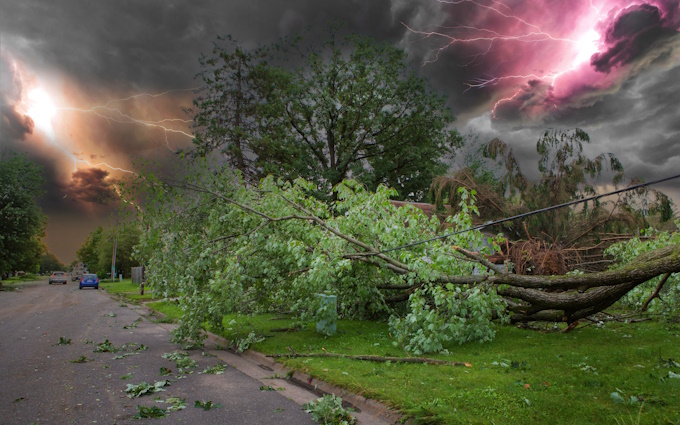An Overview of Scenarios That Warrant Emergency Tree Service and How to Request It
Midwestern weather sometimes feels like Mother Nature is using a roulette wheel to randomly determine how the day will play out. Kansas City has some of the hottest, muggiest summer days in the country. Our winters keep us guessing, offering spans of pleasant weather mixed with cold fronts so harsh that they form icicles on Andy Reid’s mustache.
Although spring is mostly temperate in this area, we do get the occasional storm and extreme weather event. Severe spring storms feature high winds, lightning, heavy rain, and flash flooding in areas lacking proper drainage. If that weren’t bad enough, spring also happens to be tornado season.
Spring storms are not to be taken lightly. They cause property damage, power outages, harm to pedestrians, and blocked roadways. Trees are susceptible to the high winds, meaning they can uproot or become structurally unstable.
After exploring spring storms and the scenarios that warrant emergency tree service, we’ll provide some tips and best practices on how to handle the situation. As one of the leading tree services in Kansas City, Eisenhower Tree Care specializes in handling emergency situations caused by spring storms.
Signs of a Tree Emergency
A tree emergency is broadly defined as any situation where a tree poses a threat to people or property. Blocking public roads also qualifies as an emergency because it may interfere with the passage of ambulances and other emergency services. Trees that have damaged power lines are also considered an emergency situation.
Watch for these signs of tree emergencies after a storm.
Uprooting
Uprooting occurs when the tree’s root system isn’t strong enough to endure high-wind scenarios, resulting in the tree’s roots coming out of the ground and fully tipping over. An uprooted tree can cause significant damage if it lands on property or nearby structures.
Leaning
Leaning trees indicate they’ve been partially uprooted, meaning they pose a risk of falling. Some leaning trees can be rehabilitated, while others may have too much root system damage to recover. Whatever the case may be, a leaning tree warrants prompt tree service to assess the situation.
Structural Damage
High winds and lightning can cause structural damage to trees, meaning the trunk or one of the main branches has suffered physical breakage and is no longer stable. Structurally damaged trees are a danger to people, property, roads, and nearby power lines. Like leaning trees, some of them can be rehabbed, while others may be too damaged to recover, especially in cases of split trunks.
What to Do During a Tree Emergency
Tree emergencies caused by spring storms range in severity. Some trees fall to the ground without hitting anything. Others may land on a house or knock out the power in your neighborhood. The good news is that there’s a step-by-step process you can follow that’s applicable to most tree emergencies.
- Maintain a safe distance and assess the situation from afar. Take pictures of the tree for insurance purposes. If the tree has landed on your home, make sure family members and pets stay away from the impacted area.
- Do NOT contact your home insurance provider right away. Many homeowners make this mistake. Calling them triggers a claim, and you don’t want to do that just yet.
- Request emergency tree service. Not all tree services provide this, so it’s best to select a company ahead of time. Eisenhower Tree Care specializes in responding to tree emergencies, and possesses the resources, equipment, and training to address storm-damaged trees.
- Emergency tree service arrives to assess the situation. After determining the extent of the damage, your tree care service professional may provide you with a few options, including branch cutting and removal, complete tree removal, and tree rehabilitation.
- After the tree emergency has been neutralized, you can move on to the insurance portion of things. Consult with your tree service professional about whether you should file a claim. Typically, homeowners only need to file a claim if a tree fell on an insured structure, such as their home or a detached garage.
- Keep all photos, invoices, and relevant documents handy. If you require roof or siding repairs, your insurance carrier will need supporting documentation for your claim.
Eisenhower Can Help You Spring into Action When Storms Hit
Spring storms are far from an everyday occurrence, but their potential impact makes them a risk worth planning for. By familiarizing yourself with the signs of a tree emergency and knowing how to respond, you won’t be caught off-guard if the worst-case scenario unfolds on your property.
You can request emergency tree service by contacting the team at Eisenhower Tree Care at (816) 237-0705. We’re one of the few tree services in Kansas City that provides 24/7 emergency support, so be sure to program our number into your phone. Learn more by visiting our emergency tree services page.

